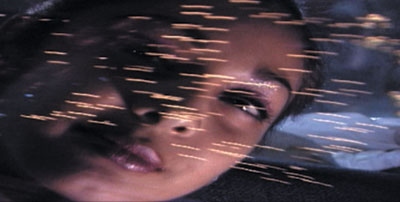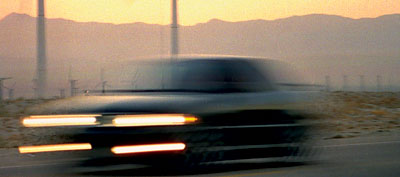SPEED KILLS
Scott Macaulay on Quattro Noza, Joey Curtis’s blindingly original look at teen romance set within L.A.’s underground street-racing scene.
 |
| Brihanna Hernandez as Noza in Quattro Noza. |
We were hauling ass 100 miles per hour on this curvey road," says Quattro Noza director, writer, editor and principal stunt driver Joey Curtis, "and then on the second pass I let my buddy Kevin lead in his Integra. He wanted to show off, and he came around this corner and had a blowout, did a complete spin and slid all across the road and flipped the car. It was like one of those science fiction movies when a ship blows up and the other ship just blasts right through the smoke. It was pretty wild – I drove through this cloud of smoke thinking, there goes the film. There was this dirt mist all around, and I stopped my car and ran back to Kevin’s. When I got there, he had already popped out of the car and was on the phone with his girlfriend! Him being okay was just one of the ways God blessed us on this film."
Anyone who thinks that stunts and car chases are only the province of big-studio entertainment must watch Quattro Noza, Curtis’s thrilling and unexpectedly poetic teen drama set within Los Angeles’s underground drag-racing community. Possessed of a real street cunning, Quattro Noza mixes documentary footage, natural and affecting performances by non-actors, and editing that moves with the grace of an ace turntablist.
Like all independent movies that mine everyday reality for their images and storylines, Quattro Noza has an off-the-cuff quality that belies the complexity of its production. The film is the story of Quattro (Robert Beaumont), a white street racer from the hills outside of L.A., who one day meets Noza (Brihanna Hernandez), a young Mexican beauty, as cops break up an illegal street race. Unbeknownst to him, she’s the girlfriend of Chato (Victor Larios), a Guatemalan-American "player" from Crenshaw who has been incarcerated in a minimum-security prison. When Noza, partially reacting to Chato’s disrespecting of her, finds herself drawn to Quattro, Chato decides to break out of jail to claim her for his own. Chato’s vendetta fuels the film’s tense and tragic final act.
Curtis began work on Quattro Noza in 1999 after he co-wrote and edited Derek Cianfrance’s film Brother Tied. "After we made Brother Tied," Curtis remembers, "it was hurtful for us because we couldn’t sell the movie because of the music rights." Although the experimental drama was acclaimed at festivals, the James Brown songs in the film were too expensive for interested distributors to pick up. Curtis moved back to Los Angeles and decided to make Quattro Noza based on his own experiences as an L.A. street racer. "Everyone I knew was scared when I said I wanted to make this movie and be the main stunt driver. My buddies and I were the first generation in 1989 – we were racing import cars, lowering them because the headers weren’t made yet. The cars from these years – 1990 to ’95 – are still the ultimate cars [for today’s street racers] because they’re not so computerized."
With a DV camera, Curtis hit the streets and found that the street-racing scene was as vibrant as ever. "I was researching all this myself, and I figured I’d bring in this kid, Robert Beaumont, who I knew from film school. He wasn’t an actor – he wanted to be a cinematographer – but I told him he had to star [as Quattro] in my movie. I’d bring him and Derek [as cinematographer] out once a month, telling them I was making a trailer. And I shot little by little."
 |
Remembers Cianfrance, who joined the production as d.p., "Joey was a street racer growing up, and he found a new crop of street-racing kids, got them all excited about the film and just start shooting. August, ’99 was the first shoot. We had Quattro, and we went out to find Noza and Chato. There wasn’t really a script, just the basic idea of this street racer. So, we walked down Melrose looking for pretty girls. We found one who thought we were perverts. And then we found Brihanna [Hernandez] walking out of a store. She couldn’t speak a word of English, but we convinced her to do the movie and that night we filmed a scene with her having hot dogs with Quattro at Pink’s."
By January, 2000, Curtis had already amassed 60 hours of footage, but, he says, "I was destroying my health. I was working 24 hours a day, editing trailers for films like What Lies Beneath and saving up money." At that point, Curtis came to New York to do some editing work for creative agency Fountainhead Creative. "I made a deal with [Fountainhead President] Fredric King. If I came in late at night, bought my own hard drives, and cut something good, he’d support it. Nobody in Hollywood would do that for me."
A month later, Curtis had "a unique half hour." With Fountainhead now on board, Curtis embarked on a month of principal photography, which included one permitted night in which L.A. police let Curtis gather 300 racers to the streets for one of the main racing scenes. Then, extended reshoots occurred months later.
"My whole concept of filmmaking," states Curtis, "is that I need as much footage as I can get because I don’t know what I’ll ultimately use. I cut to see what’s real, what’s emotional. I’d use the script as a blueprint and then, like Sergio Leone did, I would rewrite the script based on the best stuff that I cut. And then I’d reshoot to get the pieces to make the scenes work." Cianfrance says that final footage tally was a whopping 300 hours.
Of the racing scenes, Cianfrance notes, "We mounted cameras on the cars and just hit ‘record.’ When you see a car going 135 on the highway, swerving around minivans, that is really happening. When you see a cop car pull someone over, or you see someone being punched in the face, that is all really happening."
To dwell on the racing sequences, however, is to shortchange the film’s elegant and poetic style. In a film world where action is cut in 12-frame increments, Curtis has edited his film with seemingly as many layered dissolves and superimpositions as hard cuts.
Of his aesthetic, Curtis says, "I used to write a lot of poetry in high school – I was really dramatic and romantic. And then I went to University of Colorado Film School, and my professors were Stan Brakhage and Phil Solomon, who showed me these experimental films. I realized that these films were like written poetry but on film. I’ve always loved Ben Hur and Sergio Leone, but I want to create characters and be able to see the poetry in their thoughts – to try to mesh narrative cinema with this almost surrealistic cinema."
Just three weeks before Sundance, Curtis has finished his final cut, is editing sound and testing digital projection systems. Based on the 250,000 users that have come to the film’s Web site, quattronoza.com, he’s confident it will find it’s audience. "This film was a struggle," he concludes. "God was always asking me, do you really want to make this movie?" And then he spins into another anecdote: "Three days before principal photography, [actor] Albert Hernandez winds up in L.A. county jail. Without him, I couldn’t make the movie, so I stayed there for three days petitioning until I got him out.
"And now," Curtis adds, "he’s back in jail again. He’s gonna miss Sundance. I don’t think my petitioning will work a second time."
Link: http://www.quattronoza.com
VOD CALENDAR


 See the VOD Calendar →
See the VOD Calendar →


